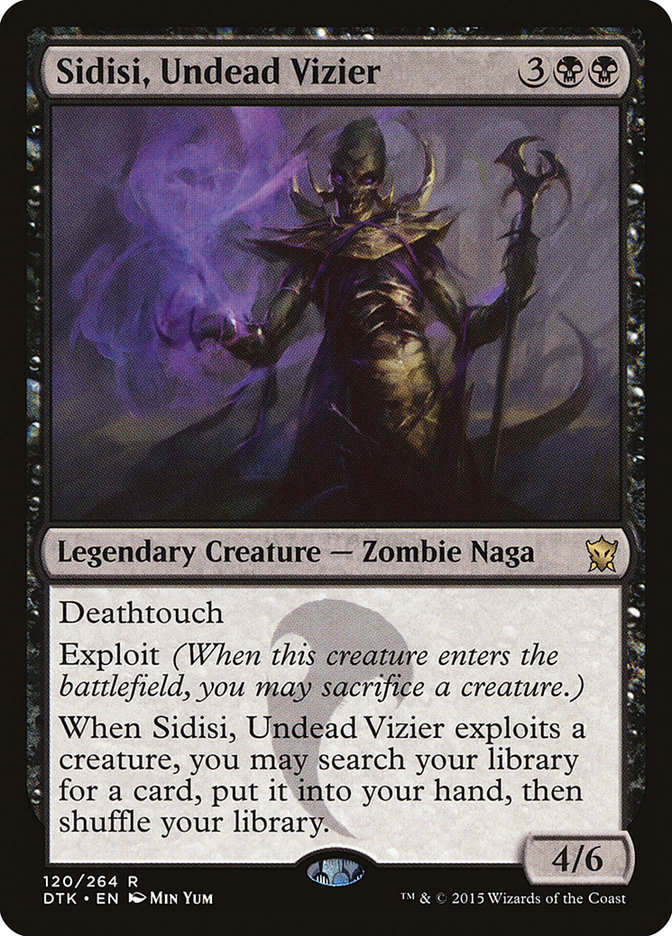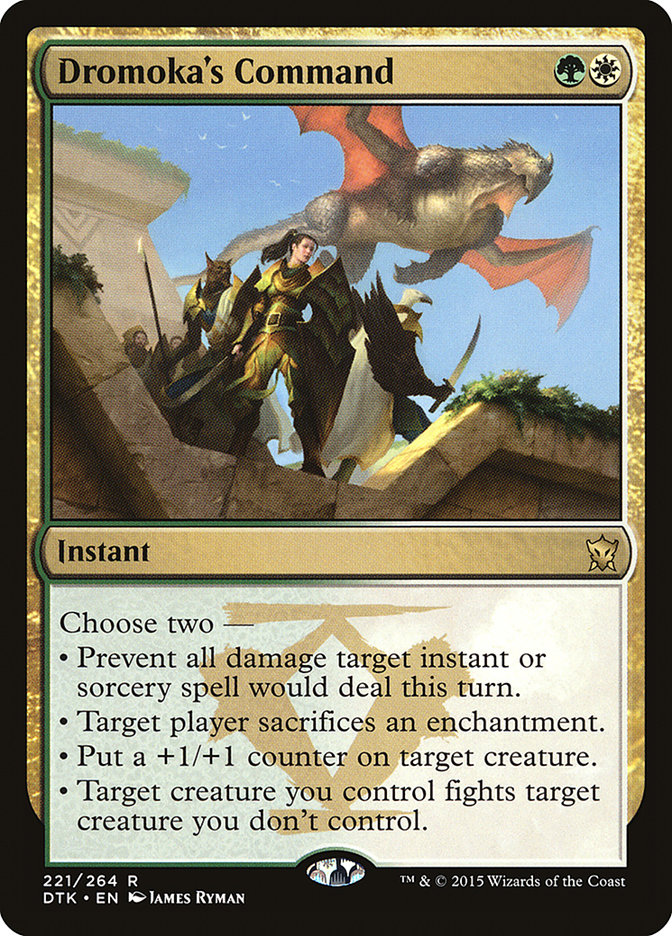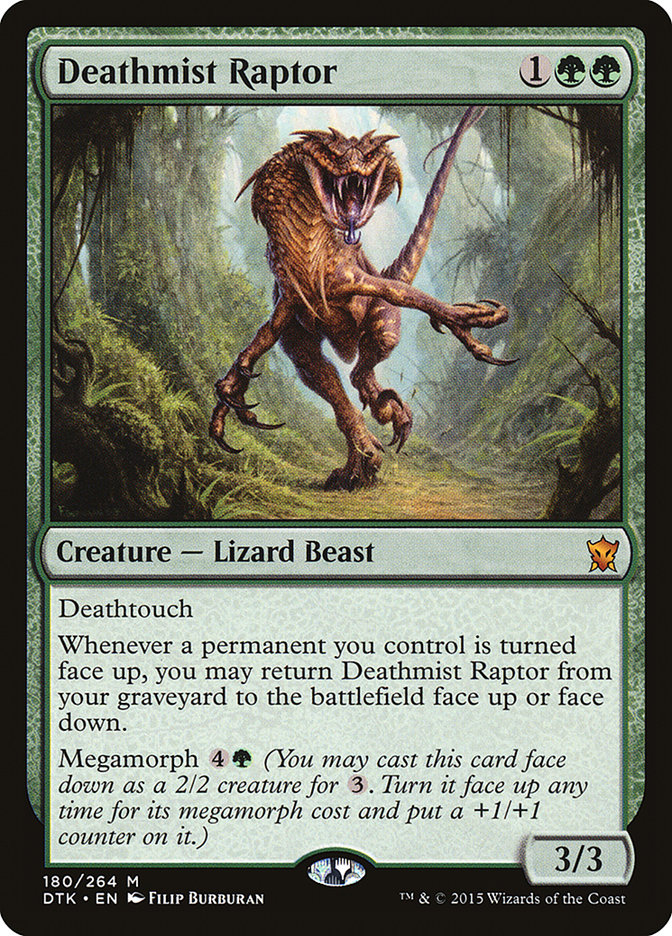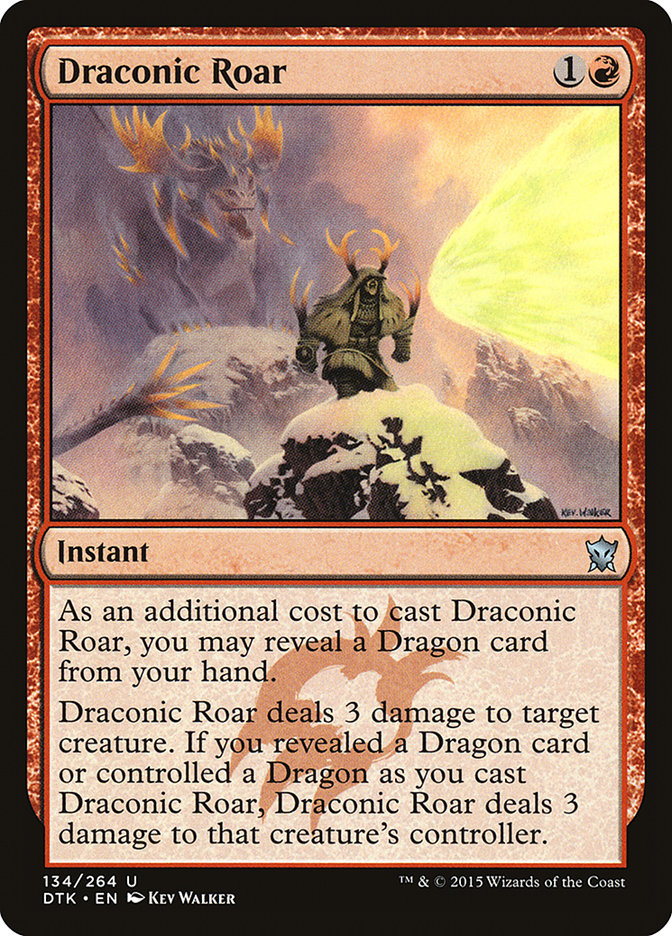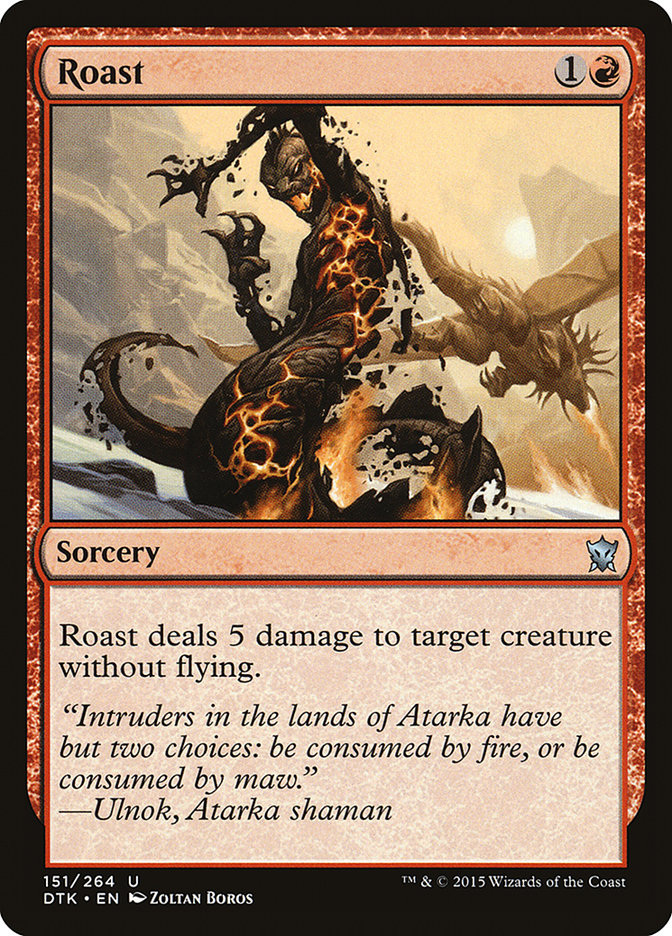The Season One Invitational this past weekend in Richmond fell just after the release date for Dragons of Tarkir, making it the first event in which the
new cards were legal. Going into the tournament, there was a lot of hype surrounding the new set, and it did not disappoint.
Today, I want to take a look at some of the top performing decks from the event.
There are two things that are important to keep in mind when evaluating the top 8 decks from Richmond. First is that the event was a multi-format
tournament, with fully half of the rounds played in Legacy. Some players, including eventual champion Jacob Wilson, found themselves in the elimination
rounds in large part due to their success in that format rather than in Standard. It’s easy to place a lot of weight on who ultimately hoists the trophy
and ignore how they got there.
Secondly, it’s the very first week of a new format. Players have not had much time to explore new strategies. As a result, we’re very likely to see heavy
bias toward modified versions of pre-existing decks rather than anything truly innovative. In fact, with Pro Tour Dragons of Tarkir on the horizon, I
wouldn’t be surprised if players like Reid Duke and Jacob Wilson intentionally chose to play decks that were known quantities so as not to give away any of
their team’s secrets. In any case, that decision certainly worked out for them, as they met in the finals with their tweaked versions of established decks.
Let’s take a look:
Creatures (16)
Planeswalkers (3)
Lands (24)
Spells (17)

Eventual champion Jacob Wilson played what on the surface looks to be a fairly standard Abzan Control list with a few miser’s one-of’s, but there’s much
more going on here than meets the eye. The key addition Dragons of Tarkir brought for this deck came in the form of Sidisi, Undead Vizier. Sidisi’s exploit
ability turns those “cute” one-of cards into a silver bullet package.
This means that Jacob has incredible access to situational removal effects like Ultimate Price, Murderous Cut, or Utter End, depending on what he needs to
deal with. It also allows him to play a single copy of the ultra powerful Garruk, Apex Predator and still have the ability to access it frequently in any
game that goes long.
Similarly, Jacob only has two copies of Elspeth, Sun’s Champion, but the deck plays like it has many more. Elspeth remains one of the strongest cards in
Standard, and with Thoughtseizes and a battery of removal spells, Jacob’s deck can try to ensure that the coast is clear for the god-slaying lady by the
time she hits the battlefield. Incidentally, Elspeth is especially powerful in combination with Sidisi since she ensures that the undead Naga has hapless
minions to exploit, even if sacrificing her own soldiers seems a little out of character for the white planeswalker.
Speaking of hapless minions, Satyr Wayfinder may quietly be the best card in this deck, possibly one of the best in all of Standard. Wayfinder is the glue
that holds so many elements of this deck together, offering fuel for the delve costs on Tasigur and Murderous cut, a body to exploit with Sidisi, the
ability to dig for the appropriate colored mana, a potential chump blocker, and more.
It doesn’t surprise me at all that Jacob’s deck performed better in the elimination rounds than in the swiss, especially once the matches were best three
games out of five. His silver bullet plan extends to the deck’s sideboard with single copies of haymakers like End Hostilities, Back to Nature, Nissa,
Worldwaker, and Ugin the Spirit Dragon all magnified in effectiveness by Sidisi’s ability to dig them up from the deck. This is a deck that can really be
tuned to handle whatever the opponent might throw at it, even just between games in a single match, and a great deal of that is due to the power of the new
Sidisi, Undead Vizier.
Speaking of decks powered by Sidisi…
Creatures (26)
- 1 Hornet Queen
- 4 Sylvan Caryatid
- 4 Courser of Kruphix
- 4 Satyr Wayfinder
- 1 Soul of Innistrad
- 1 Reclamation Sage
- 4 Sidisi, Brood Tyrant
- 1 Silumgar, the Drifting Death
- 2 Tasigur, the Golden Fang
- 1 Torrent Elemental
- 1 Dragonlord Silumgar
- 2 Sidisi, Undead Vizier
Lands (23)
Spells (11)

Double the Sidisi for double the fun! Reid’s list is a new take on the Sidisi Reanimator archetype that had so much success in the last Standard season,
now with even more Sidisi. The Brood Tyrant and Undead Vizier may not have ever existed in the same timeline in the story, but they work together well,
with the zombie tokens produced by the original Khan serving as excellent fuel for the new servant of Silumgar.
Speaking of Silumgar, Reid is able to leverage the same strengths as Jacob’s deck in terms of flexibility and added impact from singletons to play one copy
each of the old and new versions of the Dimir-colored Dragon. Incidentally, each version serves as a haymaker threat against essentially opposite
strategies. Dragonlord Silumgar is a potent weapon against decks reliant on powerful individual threats, while the Drifting Death can wipe out token armies
from Raise the Alarm, Dragon Fodder, and Hordeling Outburst.
The rest of Reid’s deck looks just like the old Sidisi Reanimator decks, except with numbers shaved to fit in more of these situational tools. He plays
only one Hornet Queen and two Whip of Erebos, cards that were previously found as two or even three copies. This allows him to make room for cards like the
Silumgars, as well as a maindeck Soul of Innistrad and Torrent Elemental for longer attrition-based games, and even a Reclamation Sage, a card that nearly
always previously started in the sideboard. These deckbuilding decisions are clearly very much due to the power of the new Sidisi at enabling such a
toolbox, and they give Reid’s deck that much more flexibility.
Much like with Jacob’s deck, the silver bullet plan spills over into the sideboard. Here, Reid has a small constellation package of two Doomwake Giants and
a single copy of Pharika, God of Affliction, which Sidisi allows him to assemble much more frequently. The Giants, along with two copies of Bile Blight and
a Drown in Sorrow, give Reid further tools against other decks built around assembling a combination of powerful small creatures, like constellation decks,
as well as token strategies.
Or perhaps decks like this one:
Creatures (30)
- 4 Elvish Mystic
- 3 Polukranos, World Eater
- 4 Sylvan Caryatid
- 3 Voyaging Satyr
- 4 Courser of Kruphix
- 3 Genesis Hydra
- 4 Whisperwood Elemental
- 1 Temur Sabertooth
- 4 Deathmist Raptor
Lands (24)
Spells (6)

Chris Andersen brought an update on the G/W Devotion deck that took Grand Prix Miami by storm. The core of his deck is the same as the version that Dan
Cecchetti used to take the trophy, but it includes a couple of new Dragons of Tarkir cards in the mix:
Dromoka’s Command is a card that many people, myself included, had pegged as among the best cards in the set. It’s clearly very powerful, and it offers a
much-needed removal effect to the G/W player’s arsenal with its fight mode. Perhaps most important is the fact that it offers playable maindeck enchantment
removal in a format filled with decks incidentally using powerful enchantments.
Cards like Outpost Siege, Chained to the Rocks, Whip of Erebos, Courser of Kruphix, and Mastery of the Unseen are everywhere. But they are not so core to
every deck’s strategy nor so ubiquitous in every deck that players can easily afford to play dedicated enchantment removal like Naturalize or Erase in
their maindeck, or even in particularly high numbers in their sideboard. But with Dromoka’s Command, players can arm themselves with a way to handle these
powerful enchantments with a card that has the flexibility to act as removal or protection from burn spells in the matchups where the other mode isn’t
effective.
The existence of Dromoka’s Command, if it turns out to be popular, actually has significant implications for deckbuilding. All of a sudden, the first
enchantment you put into any deck has a very real cost. Even the once-universal Courser of Kruphix becomes a potential liability if it means you can
possibly lose both it and another creature to the sacrifice plus fight modes on Dromoka’s Command. The card that is perhaps most heavily impacted by this
is Chained to the Rocks, which tends to be the only enchantment in aggressive R/W decks (perhaps alongside a Siege), and it can really, really hurt to
suddenly have to sacrifice mid-combat.
Deathmist Raptor has its own deckbuilding implications, mostly for the player who chooses to use it themselves. Here, Whisperwood Elemental and Mastery of
the Unseen provide a steady stream of manifests that can potentially bring a Raptor back from the graveyard to fight another day. With so many creatures in
the deck, even a single manifest has a very good chance to provide fuel for a dead Raptor to leap back into play.
G/W Devotion was already a deck with a lot of tools to play a long game, but Raptor helps shore up the earlygame as a powerful deathtouch blocker as well.
It’s especially effective against decks like Abzan Aggro that look to combine efficient attackers on the ground with removal spells to get damage in.
Pretty much only Abzan Charm can help push their creatures past it, and even then, only in the exile mode, which takes a lot of punch out of the card as a
tempo play.
Incidentally, the new cards happen to play well together. Deathtouch means that Raptor can fight any creature and kill it, no matter how big it might be.
The Raptor may die itself, but that’s what it’s there for – it’ll be back soon enough. If you recall the finals of the Grand Prix between Dan Cecchetti and
Corey Baumeister, a massive Polukranos was the deciding factor in each of the games, and that’s something the Raptor/Command combo is quite capable of
dealing with. Similarly, it provides an out to something like Dragonlord Silumgar stealing a Whisperwood Elemental, or an opposing Tasigur, or really just
about any creature threat your opponent might throw at you. And that’s a nice insurance policy to have.
Creatures (20)
- 4 Foundry Street Denizen
- 4 Eidolon of the Great Revel
- 1 Goblin Rabblemaster
- 3 Goblin Heelcutter
- 4 Lightning Berserker
- 4 Zurgo Bellstriker
Lands (21)
- 21 Mountain
Spells (19)
Sideboard

Speaking of insurance policies, can you imagine the rates you’d have to pay on Foundry Street? That seems like a really dangerous place to live, with
Goblins running around and things randomly burning everywhere. Nice place to visit for a party, but I wouldn’t want to live there.
Mono-Red decks always seem to experience a surge right after any new set release, and this time was no different. Michael Braverman was the only player to
put up a perfect 8-0 record in the Standard rounds of the Invitational, and he did so with this very interesting take on Mono-Red Aggro.
Perhaps the most notable thing about this list isn’t what it is playing, but rather what it isn’t. Michael’s deck includes only a single copy of
Goblin Rabblemaster, a card that has been a fixture of Mono-Red lists since it was released in M15 last year. Instead, Michael is playing a full complement
of token makers like Hordeling Outburst and Dragon Fodder to help fuel his Foundry Street Denizens alongside a package of dash creatures to push through
damage out of nowhere.
What leaps out at me more than anything about this list is just how strong it is against removal spells. Most aggressive Mono-Red lists with cards like
Rabblemaster and Firedrinker Satyr are soft to spot removal like Wild Slash and sweepers like Arc Lightning or Drown in Sorrow. Braverman’s combination of
tokens and dash creatures makes it hard for any particular removal package to shine against him. Against spot removal, he can flood the board with tokens,
and against sorcery speed sweepers, he can punish his opponent with Lightning Berserker as a repeatable Fireball every turn.
Even blockers are of little use. Braverman has three copies of Goblin Heelcutter alongside twelve burn spells in his maindeck to make getting in the way of
his attackers quite difficult, and Roast out of the sideboard means that even Siege Rhino or Polukranos – the natural predators of small red creatures –
can’t reliably expect to survive long enough to block.
Most of the time when I look at a Mono-Rred deck, I can easily identify a hole in their strategy that I can exploit to beat it, whether it’s big creatures,
removal, or lifegain, but here it’s not so obvious. Braverman fell to Chris Andersen’s big green creatures along with the lifegain from Mastery of the
Unseen, which is certainly a potent combination, but it is not something every deck can reasonably expect to leverage. I think this is a take on Mono-Red
that we will see continue to be successful as the format develops, as it’s fast and effective and quite resilient to the traditional weaknesses of the
strategy.
Creatures (30)
- 4 Elvish Mystic
- 4 Stormbreath Dragon
- 4 Boon Satyr
- 4 Goblin Rabblemaster
- 4 Rattleclaw Mystic
- 3 Heir of the Wilds
- 4 Thunderbreak Regent
- 3 Surrak, the Hunt Caller
Lands (23)
Spells (7)
Sideboard

It’ll probably come as no surprise to anyone that this is my favorite of the decks from the Invitational top 8. Green and red creatures together? And lots
of dragons? Where do I sign up?
Ross’s deck makes for a strong home for Thunderbreak Regent and Surrak, the Hunt Caller, two of the cards that stood out to me from the Dragons of Tarkir
spoiler as ones that I wanted to play. The Regent, in particular, is a powerful evasive threat that punishes your opponent even if they do happen to have
removal for it. One of the biggest problems with big creatures is that your opponents can generally get efficient exchanges for them with removal, which
means that you need those big creatures you do play to have an impact the turn you play them or leave something behind even if they die. Regent leaves
behind three damage to your opponent’s face, which is almost like it had haste like its bigger Stormbreath brother.
Surrak similarly can connect with the opponent’s face the turn you play him assuming you have at least three power among your other creatures when he comes
down. Between mana accelerants and Heir of the Wilds, that should generally be easy enough to achieve, and with Boon Satyr, you can even recover from a
sweeper by flashing in the 4/2 end step and then playing Surrak on your own turn to hit your opponent for nine points of damage right after they cleared
your board. Boon Satyr does open up a vulnerability to Dromoka’s Command, but it works so well with Surrak and the fliers that it would be a hard cut to
make.
The last new cards in the maindeck are Draconic Roar and Roast. When Draconic Roar is enabled, it’s a super powerful effect – Searing Blaze is good enough
that it sees play in Modern Burn. When you don’t have a Dragon, it’s still a fine removal spell, just as good as Lightning Strike for clearing out a path
for your creatures. The problem is against creature-light decks where you don’t have any good targets or as a lategame topdeck when you’re just looking to
finish an opponent off. Just how many Draconic Roars and Roasts you can afford to play in your maindeck hinges quite a bit on how many creature-light
control decks you expect to face.
A mana accelerant-heavy deck really needs to have a high density of actual threats and can only really fit so much removal, especially removal that doesn’t
double as game-winning burn like Crater’s Claws. Even Crater’s Claws feels a little weaker in this deck than normal since only Boon Satyr is a cheap
ferocious enabler. But when it comes to finishing opponents off late in the game, it’s hard to beat.
No matter what your style – blistering aggro, plodding control, or (like me) firmly in the midrange – Dragons of Tarkir has exciting new cards aimed
squarely at you. I’m excited to start testing for the Pro Tour this week, and I’m even more excited to play in it next weekend. Here’s to hoping that I can
find a sweet dragon deck to play and take the whole thing down.
What do you think? What are the most important new cards from Dragons of Tarkir, and how will they shape Standard? What do you expect to see at the Pro
Tour?

